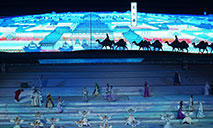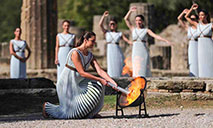Feature: Turkish ceramic artist meets new opportunities in China's "porcelain capital"
ISTANBUL, Oct. 25 (Xinhua) -- For the last 10 years in the Chinese city of Jingdezhen, Turkish ceramic artist Ekrem Yazici has been creating elegant porcelain artworks, reflecting the cultural integration of Turkey and China into his designs.
In 2009, Yazici paid his first visit to Jingdezhen, a small city in the mountains of east China's Jiangxi Province, and decided to pursue a master's degree in ceramic design at Jingdezhen Ceramics Institute.
"I have got abundant knowledge of porcelains in Western countries, while in China, I could fill gaps in knowledge about Chinese porcelain, the birthplace where porcelain has its roots," Yazici told Xinhua during a recent interview in the city, which is known as the porcelain capital of the world.
After his graduation, Yazici settled down in this city and opened his atelier.
"Almost everyone in the city is engaging in business related to porcelain," he said, noting that even in the early hours of the morning, he could see people carrying porcelain pieces.
Jingdezhen is an inclusive city where anyone, no matter whether an artist, designer, trader, or visitor, can produce porcelain with the help of craftsmen, he said.
"I am so lucky to be here, meet such a lot of opportunities, and be brave enough to take a step into an unfamiliar country," said Yazici, who is confident that he would realize his life-long dream of making porcelain in the city.
China's Jingdezhen porcelains greatly inspired Turkish tile masters since the Ottoman era and paved the way for the start of porcelain production in Turkey, a prominent Turkish porcelain expert said.
"Their value has increased manyfold due to their high quality and high artistic value and highly qualified raw material," Omur Tufan, manager of the Topkapi Palace Museum Porcelain Collection, told Xinhua, showing some unique examples of 14th-century Celadon pieces made in Jingdezhen.
The Topkapi Palace Museum in Istanbul possesses a 12,000-piece collection of Chinese porcelain, and Jingdezhen ceramics constitute 50 percent of this collection.
Tufan said the pieces from Jingdezhen have been frequently transported from China via the ancient Silk Road upon the requests of the Ottoman Sultans throughout history.
"Celadon pots of the second half of the 14th century and the beginning of the 15th century are among the rare and exquisite samples (of the collection) made in that region. The blue and white ceramic plates and bowls of the Yuan period created in the same area are also important pieces of the palace," Tufan said.
Iznik, a district of the northwestern Bursa province, "is Turkey's Jingdezhen," said Yazici, adding that the city's porcelain industry rapidly grew during the period from the 16th to 17th centuries.
"I am glad to be an envoy of Turkey-China porcelain culture and trade exchanges," he said.
Photos
Related Stories
- The secret to Jingdezhen's pre-eminence in porcelain
- Foreign potters mould dreams in China's porcelain capital
- Chinese silk embroidery, sculpture exhibition held in Turkey to mark 50-year China-Turkey ties
- Turkish aims to increase dried fruit exports to China
- Turkish sand-brewed coffee causing a stir in China
Copyright © 2021 People's Daily Online. All Rights Reserved.










